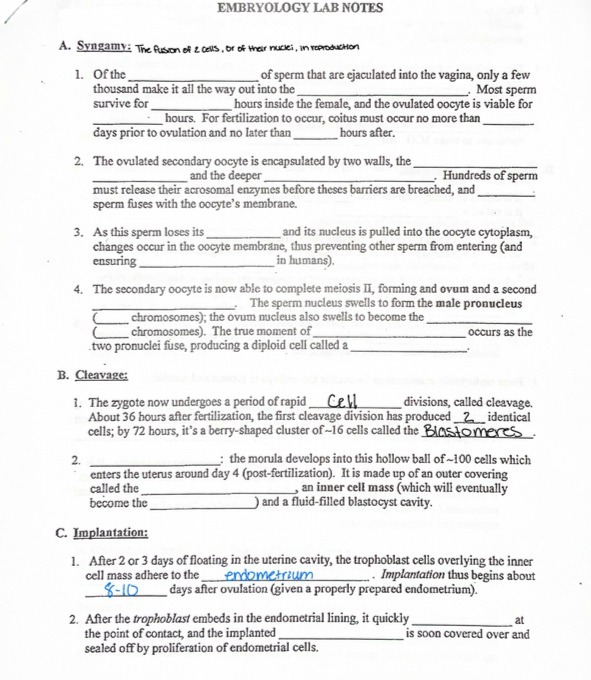EMBRYOLOGY LAB NOTES A. Syngamy: The fusion of & cells, or of their nuclei, in reproduction 1. Of the of sperm that are ejaculated into the vagina, only a few thousand make it all the way out into the Most sperm survive for hours inside the female, and the ovulated oocyte is viable for hours. For fertilization to occur, coitus must occur no more than days prior to ovulation and no later than hours after. 2. The ovulated secondary oocyte is encapsulated by two walls, the and the deeper Hundreds of sperm must release their acrosomal enzymes before theses barriers are breached, and sperm fuses with the oocyte's membrane. 3. As this sperm loses its and its nucleus is pulled into the oocyte cytoplasm, changes occur in the oocyte membrane, thus preventing other sperm from entering (and ensuring in humans). 4. The secondary oocyte is now able to complete meiosis II, forming and ovum and a second . The sperm nucleus swells to form the male pronucleus chromosomes); the ovum nucleus also swells to become the chromosomes). The true moment of occurs as the two pronuclei fuse, producing a diploid cell called a B. Cleavage: 1. The zygote now undergoes a period of rapid Cell divisions, called cleavage. About 36 hours after fertilization, the first cleavage division has produced _2 _identical cells; by 72 hours, it's a berry-shaped cluster of -16 cells called the Blastomere's 2. the morula develops into this hollow ball of -100 cells which enters the uterus around day 4 (post-fertilization). It is made up of an outer covering called the an inner cell mass (which will eventually become the ) and a fluid-filled blastocyst cavity. C. Implantation: 1. After 2 or 3 days of floating in the uterine cavity, the trophoblast cells overlying the inner cell mass adhere to the_endometrium . Implantation thus begins about 4-10 days after ovulation (given a properly prepared endometrium). 2. After the trophoblast embeds in the endometrial lining, it quickly at the point of contact, and the implanted is soon covered over and sealed off by proliferation of endometrial cells







